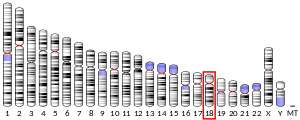MOCOS
Molybdenum cofactor sulfurase is an enzyme that in humans is encoded by the MOCOS gene.[5][6]
MOCOS sulfurates the molybdenum cofactor of xanthine dehydrogenase (XDH) and aldehyde oxidase (AOX1), which is required for their enzymatic activities.[5]
References
- 1 2 3 GRCh38: Ensembl release 89: ENSG00000075643 - Ensembl, May 2017
- 1 2 3 GRCm38: Ensembl release 89: ENSMUSG00000039616 - Ensembl, May 2017
- ↑ "Human PubMed Reference:".
- ↑ "Mouse PubMed Reference:".
- 1 2 Ichida K, Matsumura T, Sakuma R, Hosoya T, Nishino T (Apr 2001). "Mutation of human molybdenum cofactor sulfurase gene is responsible for classical xanthinuria type II". Biochem Biophys Res Commun. 282 (5): 1194–200. doi:10.1006/bbrc.2001.4719. PMID 11302742.
- ↑ "Entrez Gene: MOCOS molybdenum cofactor sulfurase".
Further reading
- Maruyama K, Sugano S (1994). "Oligo-capping: a simple method to replace the cap structure of eukaryotic mRNAs with oligoribonucleotides". Gene. 138 (1–2): 171–4. doi:10.1016/0378-1119(94)90802-8. PMID 8125298.
- Suzuki Y, Yoshitomo-Nakagawa K, Maruyama K, et al. (1997). "Construction and characterization of a full length-enriched and a 5'-end-enriched cDNA library". Gene. 200 (1–2): 149–56. doi:10.1016/S0378-1119(97)00411-3. PMID 9373149.
- Strausberg RL, Feingold EA, Grouse LH (2003). "Generation and initial analysis of more than 15,000 full-length human and mouse cDNA sequences". Proc. Natl. Acad. Sci. U.S.A. 99 (26): 16899–903. doi:10.1073/pnas.242603899. PMC 139241. PMID 12477932.
- Yamamoto T, Moriwaki Y, Takahashi S (2003). "Identification of a new point mutation in the human molybdenum cofactor sulferase gene that is responsible for xanthinuria type II". Metab. Clin. Exp. 52 (11): 1501–4. doi:10.1016/s0026-0495(03)00272-5. PMID 14624414.
- Beausoleil SA, Jedrychowski M, Schwartz D (2004). "Large-scale characterization of HeLa cell nuclear phosphoproteins". Proc. Natl. Acad. Sci. U.S.A. 101 (33): 12130–5. doi:10.1073/pnas.0404720101. PMC 514446. PMID 15302935.
- Gerhard DS, Wagner L, Feingold EA (2004). "The status, quality, and expansion of the NIH full-length cDNA project: the Mammalian Gene Collection (MGC)". Genome Res. 14 (10B): 2121–7. doi:10.1101/gr.2596504. PMC 528928. PMID 15489334.
- Beausoleil SA, Villén J, Gerber SA (2006). "A probability-based approach for high-throughput protein phosphorylation analysis and site localization". Nat. Biotechnol. 24 (10): 1285–92. doi:10.1038/nbt1240. PMID 16964243.
- Peretz H, Naamati MS, Levartovsky D (2007). "Identification and characterization of the first mutation (Arg776Cys) in the C-terminal domain of the Human Molybdenum Cofactor Sulfurase (HMCS) associated with type II classical xanthinuria". Mol. Genet. Metab. 91 (1): 23–9. doi:10.1016/j.ymgme.2007.02.005. PMID 17368066.
This article is issued from
Wikipedia.
The text is licensed under Creative Commons - Attribution - Sharealike.
Additional terms may apply for the media files.




